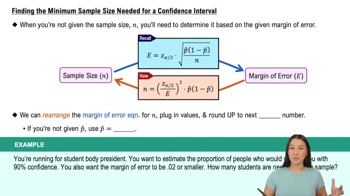Table of contents
- 1. Intro to Stats and Collecting Data55m
- 2. Describing Data with Tables and Graphs1h 55m
- 3. Describing Data Numerically1h 45m
- 4. Probability2h 16m
- 5. Binomial Distribution & Discrete Random Variables2h 33m
- 6. Normal Distribution and Continuous Random Variables1h 38m
- 7. Sampling Distributions & Confidence Intervals: Mean1h 3m
- 8. Sampling Distributions & Confidence Intervals: Proportion1h 12m
- 9. Hypothesis Testing for One Sample1h 1m
- 10. Hypothesis Testing for Two Samples2h 8m
- 11. Correlation48m
- 12. Regression1h 4m
- 13. Chi-Square Tests & Goodness of Fit1h 20m
- 14. ANOVA1h 0m
8. Sampling Distributions & Confidence Intervals: Proportion
Confidence Intervals for Population Proportion
Problem 7.1.22
Textbook Question
"Critical Thinking. In Exercises 17ŌĆō28, use the data and confidence level to construct a confidence interval estimate of p, then address the given question.
Internet Use A random sample of 5005 adults in the United States includes 751 who do not use the Internet (based on three Pew Research Center polls). Construct a 95% confidence interval estimate of the percentage of U.S. adults who do not use the Internet. Based on the result, does it appear that the percentage of U.S. adults who do not use the Internet is different from 48%, which was the percentage in the year 2000?"
 Verified step by step guidance
Verified step by step guidance1
Step 1: Identify the sample proportion (p̂). The sample proportion is calculated as the number of successes (in this case, adults who do not use the Internet) divided by the total sample size. Use the formula: p̂ = x / n, where x = 751 and n = 5005.
Step 2: Calculate the standard error (SE) for the sample proportion. The formula for the standard error is: SE = sqrt((p̂ * (1 - p̂)) / n). Substitute the value of p̂ from Step 1 and the sample size n = 5005 into this formula.
Step 3: Determine the critical value (z*) for a 95% confidence level. For a 95% confidence level, the critical value z* is approximately 1.96 (based on the standard normal distribution).
Step 4: Construct the confidence interval for the population proportion (p). Use the formula: Confidence Interval = p╠é ┬▒ z* ├Ś SE. Substitute the values of p╠é, z*, and SE from the previous steps into this formula to calculate the lower and upper bounds of the confidence interval.
Step 5: Compare the confidence interval to the value 48% (0.48). Check if 0.48 lies within the confidence interval. If it does not, conclude that the percentage of U.S. adults who do not use the Internet is significantly different from 48%. If it does, conclude that there is no significant difference.
 Verified video answer for a similar problem:
Verified video answer for a similar problem:This video solution was recommended by our tutors as helpful for the problem above
Video duration:
5mPlay a video:
Was this helpful?
Key Concepts
Here are the essential concepts you must grasp in order to answer the question correctly.
Confidence Interval
A confidence interval is a range of values, derived from sample statistics, that is likely to contain the true population parameter with a specified level of confidence. For example, a 95% confidence interval suggests that if we were to take many samples and construct intervals in the same way, approximately 95% of those intervals would contain the true population proportion.
Recommended video:

Introduction to Confidence Intervals
Sample Proportion
The sample proportion is the ratio of the number of successes (in this case, adults who do not use the Internet) to the total number of observations in the sample. It is calculated as p̂ = x/n, where x is the number of successes and n is the sample size. This value is crucial for estimating the population proportion and constructing the confidence interval.
Recommended video:

Sampling Distribution of Sample Proportion
Hypothesis Testing
Hypothesis testing is a statistical method used to make inferences about population parameters based on sample data. In this context, it involves comparing the constructed confidence interval to the historical percentage of 48% to determine if there is a statistically significant difference in the proportion of U.S. adults who do not use the Internet compared to the year 2000.
Recommended video:
Guided course

Step 1: Write Hypotheses

 5:45m
5:45mWatch next
Master Constructing Confidence Intervals for Proportions with a bite sized video explanation from Patrick
Start learningRelated Videos
Related Practice






